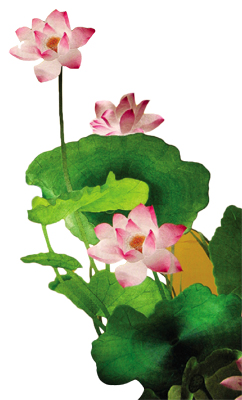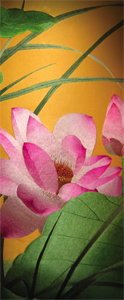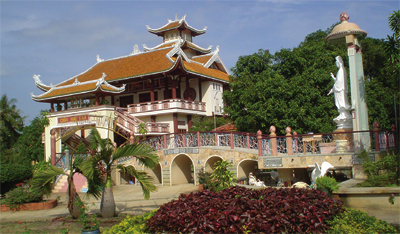Sakyadhita is pleased to announce the 11th Sakyadhita International Conference on Buddhist Women, to be held in Ho Chi Minh City from December 28, 2009, to January 3, 2010. Temple tours in the vicinity of Ho Chi Minh City will be arranged for January 4 to 5. Optional tours to Hue and Hanoi are available from January 6 to 10.

The conference theme, “Eminent Buddhist Women,” will highlight the achievements of Buddhist Women around the world. Until recently, women were largely absent from Buddhist histories. Since 1987, Sakyadhita members have made conscientious efforts to encourage research on the lives and achievements of both laywomen and nuns in Buddhist societies. The 11th Sakyadhita Conference will encourage further research and reflection on these achievements.

Dharma in Motion, Mindfulness in Action
Diversity: Meditation Traditions
Leadership for Buddhist Women’s Groups
Dharma with Children: East and West
Compassionate Communications
Understanding Domestic Violence
Engaging Buddhist Laywomen
Mindful Asian Dance: Cultural Impact along the Buddhist Path
Conflict Transformation
Buddhist Practice in Relationships

December 27 : Arrival in Ho Chi Minh City
December 28 : Opening Ceremony
Dec 29-Jan 2 : Conference Sessions: Meditation, talks, discussions, and workshops
January 3 : Closing Ceremony
January 4-5 : Temple Tour in the vicinity of Ho Chi Minh City
January 6-10 : Optional tours to Hue and Hanoi

A non-refundable conference fee of US $50 guarantees your registration.

Registrations must be received by October 1. Space is limited, so be sure to register early.

Buddhist Women and Leadership
Eminent Women in Buddhist History
Buddhist Women Teachers: Lay and Ordained
Dialogue Across Cultures: Defining Eminence
Socially Engaged Buddhist Women
Dharma Across Generations and Cultures
Buddhist Women and Global Poverty
Teaching Dharma in Prisons
Buddhist Women and Diverse Lifestyles
Buddhist Education Across Cultures
Living Simply, Protecting the Environment

Sponsor a nun or laywoman from a developing country to attend the conference! Only with your help will women from Bangladesh, Bhutan, Burma, Cambodia, India, Laos, Mongolia, Nepal, Thailand, or Sri Lanka get this chance. A Sakyadhita conference experience nurtures women and encourages them to become leaders of their communities.
Not able to attend the conference yourself? Lend a hand to help a deserving nun or laywoman attend! All she needs is an air ticket. Kind Vietnamese Buddhists will arrange for her food, accommodations, registration, and temple tour! Unable to help financially? Sakyadhita welcomes your help with the conference planning!

❏ Registration fee: $50 (includes meals, but not accommodations)
Meals (December 28-January 3/5), choose one:
❏ Breakfast, lunch, and tea
❏ Breakfast, lunch, tea and evening meal
 I am interested in the following accommodations:
I am interested in the following accommodations:
❏ $40/night ❏ $30/night ❏ $20/night ❏ $10/night ❏ Single room ❏ Double room
❏ I wish to share with …………………
❏ Airport transfer on December 27
❏ Temple tour on January 4-5
❏ Please send information on optional tours to Hue and Hanoi on January 6-10
❏ Help sponsor a woman from a developing country:
❏ $30 ❏ $50 ❏ $100 ❏ $200 ❏ $500 ❏ $800 ❏ Other…………………..
❏ I would like to sponsor a ❏ nun ❏ laywoman from ……………………………………… (country/tradition)
$ ……………………. Total amount enclosed
❏ I can offer the following talents or ideas:
……………………………………………………………………………………………………..
……………………………………………………………………………………………………..
Name:………………………………………………………………………………….
Address:…………………………………………………………………………………..
…………………………………………………………………………………
Country:………………………………………………………………………………….
Phone/Fax:………………………………………………………………………………
Email:………………………………………………………………………………….
Sakyadhita
International Association of Buddhist Women
923 Mokapu Blvd.
Kailua, HI 96734 U.S.A.
Email: sakyadhita@gmail.com
www.sakyadhita.org

About Vietnam
 According to legend, the Vietnamese people are descendants of a dragon and a fairy. Archaeologists tell us that human beings have inhabited the land for at least 400,000 years. A golden age of Dong Son culture flourished during the first millennium BCE, followed by a millennium of Han domination and feudal culture. After the tenth century CE, the country thrived under a succession of centralized Vietnamese dynasties. The French invaded in 1858 and ruled the country from 1884 to 1945, when the Democratic Republic of Vietnam declared its independence from both the French and the Japanese. The country suffered thirty years of war and was finally reunited in 1975.
According to legend, the Vietnamese people are descendants of a dragon and a fairy. Archaeologists tell us that human beings have inhabited the land for at least 400,000 years. A golden age of Dong Son culture flourished during the first millennium BCE, followed by a millennium of Han domination and feudal culture. After the tenth century CE, the country thrived under a succession of centralized Vietnamese dynasties. The French invaded in 1858 and ruled the country from 1884 to 1945, when the Democratic Republic of Vietnam declared its independence from both the French and the Japanese. The country suffered thirty years of war and was finally reunited in 1975.
Bordered by Cambodia, Laos, China, and the South China Sea, the landscape of Vietnam includes a thousand miles (1,400 km) of tropical coastline, verdant mountains, and shimmering rice paddies. The population of 87 million is made up of 54 ethnic groups which create a kaleidoscope of peoples, cultures, and religions.
Indigenous Vietnamese, Chinese, Cham, and French cultural influences are interwoven in the art, complex court dances, water puppetry, folk opera, ancient chamber music, silk painting, architecture, and many varieties of traditional dance. Contemporary cultural life is rich with film, painting, poetry, classical and modern music, literature, and an array of handicrafts from every corner of the country.
Vietnamese cuisine is unique, fun, and delicious! Along with a wide range of non-vegetarian choices, Buddhist influence has contributed many vegetarian entrees and side dishes with dipping sauces. There is an emphasis on freshness, with delicate, balanced flavors. Vietnamese curries, wraps of all kinds, soups, noodles, rice dishes, and French-inspired bakeries abound.
The spiritual culture of Vietnam encompasses Buddhism, Taoism, Confucianism, Catholicism, and indigenous religious traditions such as Cao Dai and Hoa Hao. More than 60 percent of the Vietnamese follow some form of Buddhist practice, including Theravada, Mahayana, and the Mendicant tradition.

Buddhism in Vietnam
Buddhism was transmitted to Vietnam in the first century BCE, when monks arrived from South India by sea, and in the second century CE, when monks arrived by land from China. Another influx occurred in the sixth century when the Khmer kingdom was founded near Hue, in central Vietnam. Over time, two Zen (Thien) lineages were established in Vietnam, one from India and one from China. In 1115, Dieu Nhan became the first Vietnamese bhiksuni and founded the Bhiksuni Sangha in Vietnam. Vietnamese homes often display images and sutras dedicated to Quan Am, the bodhisattva of compassion.
Vietnamese Buddhism is quite diverse. Northerners tend to favor Thien (Zen) practice, while southerners tend to prefer Dao Tang (Pure Land). Along the Cambodian border to the southwest, there are many Theravada communities, with ochre-robed monks and nuns going on their daily alms rounds. Monks and nuns of the indigenous Mendicant tradition dress in yellow robes. Each tradition has its own style of chanting and an active calendar of Buddhist festivals throughout the year. In Vietnam, monastic practitioners enjoy great respect. Nuns have equal access to Buddhist education and full ordination, and are very active in social welfare work.

Conference Location
 The 11th Sakyadhita International Conference on Buddhist Women will be held at Universal Light Monastery in central Ho Chi Minh City (formerly Saigon). This bustling metropolis lies on the west bank of the Mekong River, one of the largest and most beautiful rivers of Asia. Ho Chi Minh City is Vietnam’s commercial and industrial center. In addition to its many lovely temples and pagodas, the city also bustles with motorcycles, cars, factories, restaurants, and commerce. The Vietnamese speak a tonal language transcribed in a western phonetic alphabet. Although Vietnamese was originally written in Chinese characters, today only scholars and monastics can read or write these characters. Most young people speak some English, older people may speak French, and Vietnamese of Chinese ancestry may speak Chinese.
The 11th Sakyadhita International Conference on Buddhist Women will be held at Universal Light Monastery in central Ho Chi Minh City (formerly Saigon). This bustling metropolis lies on the west bank of the Mekong River, one of the largest and most beautiful rivers of Asia. Ho Chi Minh City is Vietnam’s commercial and industrial center. In addition to its many lovely temples and pagodas, the city also bustles with motorcycles, cars, factories, restaurants, and commerce. The Vietnamese speak a tonal language transcribed in a western phonetic alphabet. Although Vietnamese was originally written in Chinese characters, today only scholars and monastics can read or write these characters. Most young people speak some English, older people may speak French, and Vietnamese of Chinese ancestry may speak Chinese.

Travel To Vietnam
Ho Chi Minh City in December and January can be very hot and humid during the day with temperatures approaching 95 F (32 C). Temperatures at night and the early morning may be quite cool and damp, reaching as low as 60 F (15 C). Temperatures in the north are considerably cooler.
All visitors in the Socialist Republic of Vietnam will need passports (valid for at least six months from the date of entry) and visas. Contact the Embassy of Vietnam in your country for information on visa requirements and applications. Be sure to allow sufficient time for processing.
More informations – www.sakyadhita.org – sakyadhita@gmail.com






